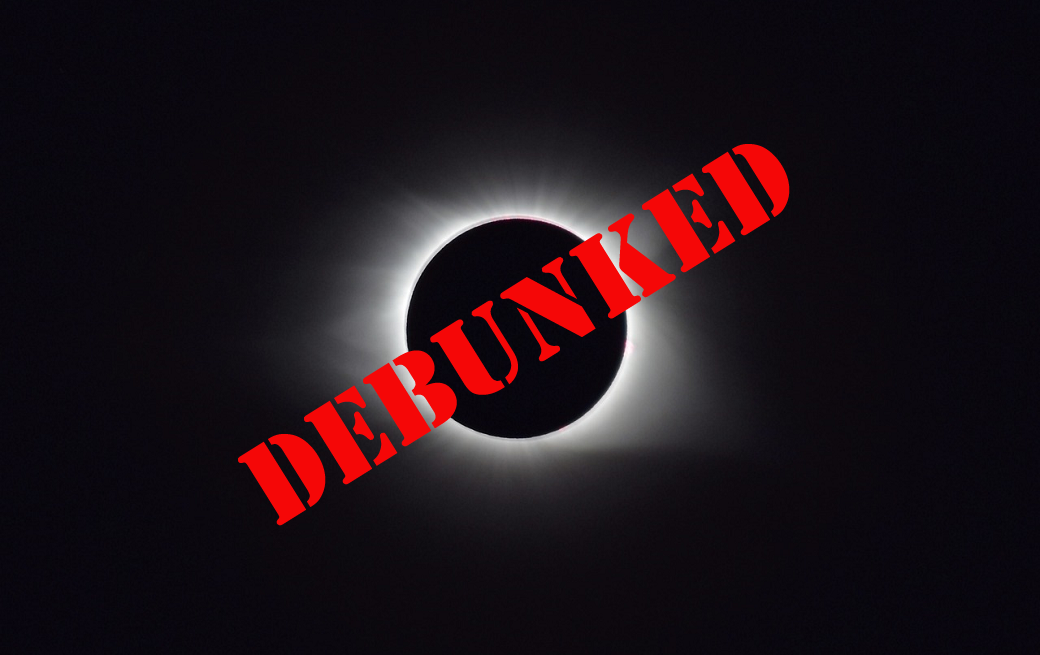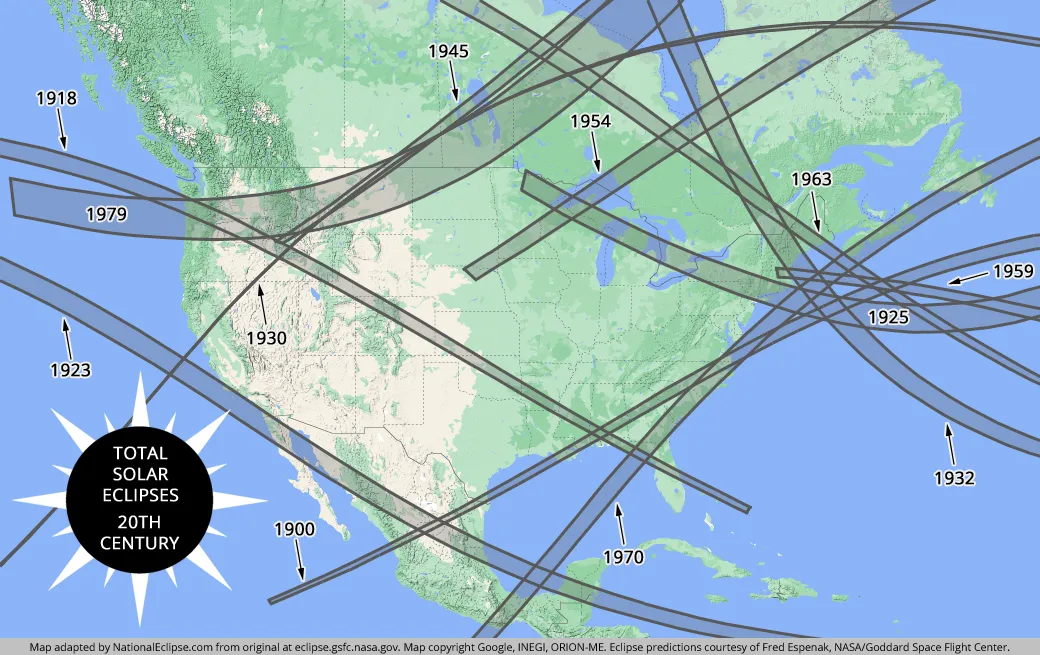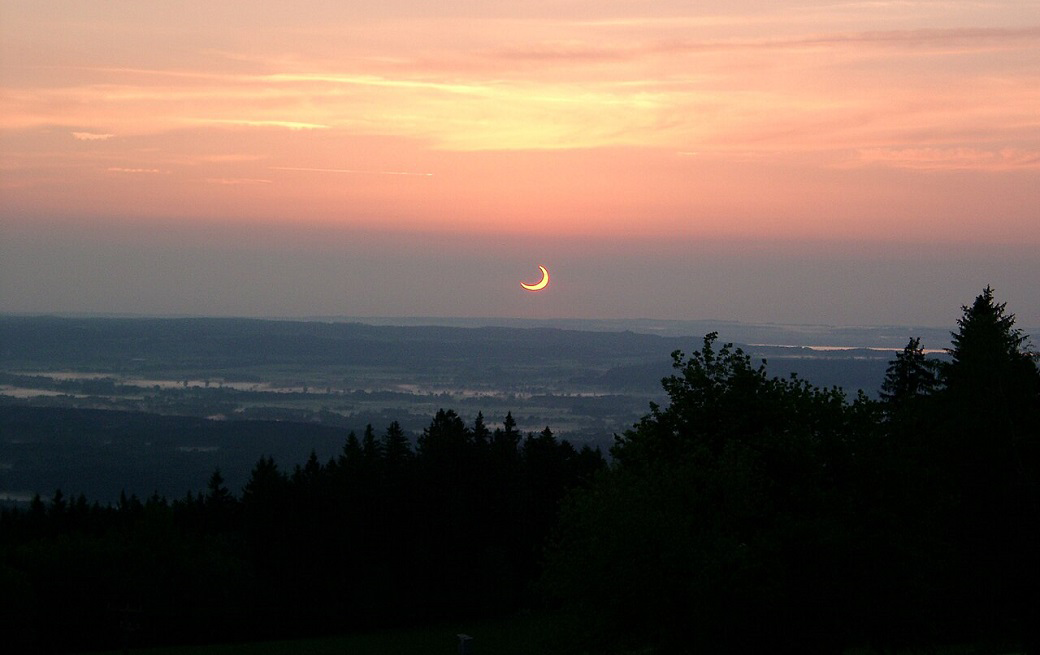NationalEclipse.com | Apr 4, 2017 | National Eclipse Blog

In our last post, "Staying Safe on August 21," we called attention to the fact that the media sometimes inadvertently provides incorrect or dangerous information about how to safely view a solar eclipse. Needless to say, this is a disturbing pattern because so many people never think to verify or fact check what they read or hear in the news. Unfortunately, that blind faith can lead to irreparable eye damage on August 21.
But the media, and people in general, also make other kinds of factual mistakes and false assumptions when it comes to the subject of solar eclipses. Some of these errors are the result of long-held beliefs; others are simply due to an innocent mistake that quickly spreads and propagates online. Although these mistakes don't necessarily put anyone in danger, they do undermine the public's understanding and appreciation of the 2017 eclipse and eclipses in general. To help set the record straight, here are some of the more common eclipse-related inaccuracies and our efforts to debunk them:
DEBUNKED: The 2017 Eclipse Will be a "Rare" Event
The word "rare" is a relative term. Its meaning depends on the context in which it's used. A total solar eclipse isn't a particularly rare event when you consider that one happens someplace on Earth about once every 18 months. If you wanted to, and if you had the resources to do so, you could see dozens of them in a lifetime. What most people would consider rare is the occurrence of a total solar eclipse for any one spot on Earth. It's been calculated that, on average, a total solar eclipse can be seen from the same place only once every 375 years, although the time span can also be much more or much less. So, will the 2017 eclipse be a "rare" event? Not for the planet. But maybe for your city. Let's just try to keep things in perspective.
DEBUNKED: The 2017 Eclipse Will be the First Total Solar Eclipse in the U.S. Since 1918
This is a fallacy that's been spreading online by way of several recent news stories. Of course, this spawns more news stories, and on and on we go. In fact, the eclipse on August 21, 2017, will be the sixteenth total solar eclipse visible in the U.S. since 1918, ten of which occurred in the contiguous 48 states. So, where does the confusion come from and what does 1918 have to do with anything? 1918 was the last time a total solar eclipse crossed the U.S. from coast to coast, which the 2017 eclipse will also do. This has led to a lot of talk about the 1918 eclipse in particular, and some people have jumped to the conclusion that that eclipse was also the last one to occur in the U.S. Not so. Just ask those who witnessed totality in the Hawaiian Islands in 1991 or in the Pacific Northwest in 1979.

DEBUNKED: The 2017 Eclipse Will be the First Total Solar Eclipse Exclusive to the U.S. Since 1776
Okay, maybe we're splitting hairs with this one, because this statement is essentially correct. But the way it's often worded can be misleading. One of the most exciting things about the 2017 eclipse is the fact that it will be the first eclipse with a path of totality that doesn't touch any other country other than the United States since before there even was a United States. You have to look all the way back to 1257 to find another total eclipse that was exclusive to present-day U.S. soil. But there was no total solar eclipse in the U.S. in 1776. There wasn't one anywhere in the world that year. A better way to word this claim would be to say that the 2017 eclipse will be the first total solar eclipse exclusive to the U.S. since before the nation's founding in 1776. Come to think of it, if there had been a total eclipse over the 13 original colonies in 1776, the symbolism it might have suggested to the patriots could very well have become part of the American historical tradition.
DEBUNKED: City X Will be the Best Place to View the 2017 Eclipse
This is a claim that you'll see quite often. And—no surprise—it's usually made by a local newspaper or tourist bureau. There is no single "best" or "greatest" place to see the 2017 eclipse. Every eclipse chaser needs to evaluate what's most important to them and then decide where their own personal "best" place is. If you need to travel to see the eclipse, should you choose the closest location to your home or should you visit another area with other attractions that you've always wanted to see? Or maybe better weather odds in another part of the country is more important to you. And, of course, you need to factor in your distance to the centerline to ensure a long duration of totality. Should you locate yourself directly on the centerline and squeeze every second of totality out of your experience? Some cities and towns on the centerline would like you to do that. But maybe it makes more sense to sacrifice a few seconds of totality in another place that has better weather prospects in late August. These are the difficult questions that you need to ask yourself. When you've come up with an answer, you'll have found your own "best" place to view the 2017 eclipse.
DEBUNKED: The 2017 Eclipse Will be a Lunar Eclipse
We're not going to spend a lot of time on this one because it's so annoyingly untrue and the result of journalistic sloppiness more than anything else. But you will see this statement from time to time, sometimes in the headlines of newspaper articles. Usually, the reporter correctly states in the body of the article that the eclipse will be solar but someone else at the newspaper is responsible for writing headlines and they don't have a clue that a lunar eclipse and a solar eclipse are two completely different things. The terms are not interchangeable in the least. Hopefully, this misconception will peter out as we get closer to August 21.
DEBUNKED: The 2017 Eclipse Will be a "Sunrise" Eclipse
This is a fallacy that's been making the rounds recently. Apparently, somebody noticed that the 2017 eclipse will begin at sunrise. But, guess what? Every total eclipse begins at sunrise! And every total eclipse also ends at sunset. Sometimes, by mere chance, an eclipse will begin over land instead of over water, which means that people in that location are able to see an "eclipse sunrise." But the path of totality doesn't start over land on August 21. It starts at sunrise in the North Pacific Ocean about halfway between Hawaii and Alaska's Aleutian Islands. By the time it makes landfall in Oregon, the local time will be 9:04am with the Sun already about 27 degrees above the horizon. Nobody within the path of totality will see a "sunrise" eclipse on August 21.

DEBUNKED: Being Close to the Path of Totality is Close Enough
For a total solar eclipse, the path of totality is the narrow track across the Earth along which the darkest part of the Moon's shadow, the umbra, will travel. On either side of the path's width an eclipse is only partial, with the percentage of obscuration incrementally decreasing the farther you get from the edge of the path. Some people make the false assumption that being close to this path is close enough. After all, a 98 or 99 percent partial eclipse sounds impressive. But the difference between a total eclipse and even a 99.9 percent partial eclipse is like the difference between day and night, literally. It's like turning a light on and off. There's no in-between. Either you're in the path of totality where the eclipse will be total or you're not. If you're outside the path by even a mile, you'll miss out on all of the phenomena associated with a total solar eclipse, like the full darkening of the sky, the appearance of the solar corona, and the 360-degree "sunset." True, you'll still experience some subtle eclipse effects even a few hundred miles outside the path of totality. Depending on how deep the partial eclipse is in your location, you might notice a change in the character of the sunlight and the landscape might take on a slightly unusual look. But this pales in comparison to what you'll witness inside the umbral path. Trust us. When it comes to eclipses, close isn't close enough.
DEBUNKED: The World Will End on August 21
Sigh. Does this really need to be debunked? Inevitably, though, you've probably already started seeing doomsday claims associated with August 21. If the world does indeed end on August 21, you can tell us "we told you so." But there's no basis whatsoever for these claims. The world doesn't end every time the Sun goes behind a cloud. Neither are there earthquakes or volcanoes. There's really nothing "special" about a solar eclipse in terms of the effect it has on the Earth. Yes, the temperature decreases during totality and scientists have discovered other subtle phenomena. But there's nothing that's, literally, earthshaking. From a biblical or spiritual perspective, we need to remember that total eclipses happen all the time, relatively speaking. There was one last year. There was one in the U.S. in 1979 and 1991. As many as five solar eclipses can occur each year. The purpose here isn't to ridicule any person or any group who makes these assertions, but some people are legitimately afraid when they hear these claims. We don't want the 2017 eclipse to be the cause of fear. We want people to look forward to this event and celebrate it when it arrives. It will be an amazing opportunity to witness the mechanics of our solar system and an awe-inspiring celestial phenomenon that most people will never get the chance to experience.